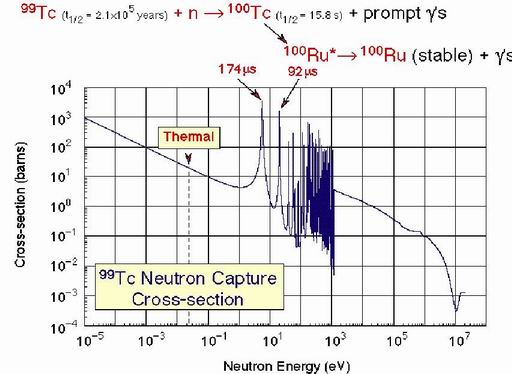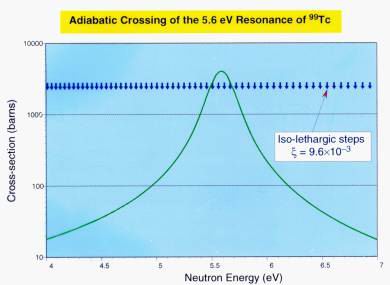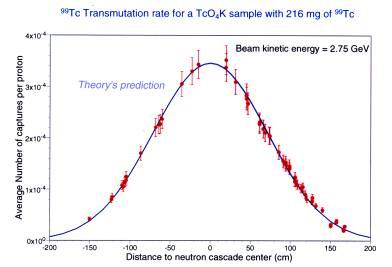Neutron Dynamics
The source of neutrons
is surrounded by a diffusing medium in which neutrons propagate. The
sample to be activated is located in a dispersed form inside the medium
(as a “impurity”).
Typically, this medium is Lead (Pb), whose properties are extraordinarily good for the purpose of the transmuter: to enhance the neutron capture by the material to transmute:
1. Lead is "transparent" to neutrons.
2. Lead is highly diffusive.
Transparency is the property of the medium in which neutrons undergo mostly elastic scattering. (Little elastic hits with a very small energy loss). Both properties means that lead provides a very small probability of absorbing neutrons while a very isotropic probability of elastic scattering.
The succession of many closely elastic scattering events gives to the neutrons a random propagation in the medium. Each neutron looses very little energy in each collision. They traverse the whole energy spectrum (1 MeV – 0.025 eV) in multiple steps: before the neutron loose most of its energy, about 1800 collisions and 60 m of random path will happen. But the total migration length is only ≈ 1.2 m from the source. That means neutrons remain confined in a lead volume of » 4 m side. (This is a very important point because determine the size of the device).
If impurities (the sample to activate) are present having resonances in the cross section (see figure) , they are transmuted into isotopes having A+1 (stables or with short
life-time). This method is known as "Adiabatic Resonance Crossing".
, they are transmuted into isotopes having A+1 (stables or with short
life-time). This method is known as "Adiabatic Resonance Crossing".
As an example, we can see how the neutron crosses in very tiny steps one of the resonances of the 99Tc.

The probability of capture of the neutron by the 99Tc is very high!
This is the theory, but what about the experience?.

The experiments (red dots) lead by Prof. Carlo Rubbia at CERN show how close to the predictions (blue curve) they were:
Typically, this medium is Lead (Pb), whose properties are extraordinarily good for the purpose of the transmuter: to enhance the neutron capture by the material to transmute:
1. Lead is "transparent" to neutrons.
2. Lead is highly diffusive.
Transparency is the property of the medium in which neutrons undergo mostly elastic scattering. (Little elastic hits with a very small energy loss). Both properties means that lead provides a very small probability of absorbing neutrons while a very isotropic probability of elastic scattering.
The succession of many closely elastic scattering events gives to the neutrons a random propagation in the medium. Each neutron looses very little energy in each collision. They traverse the whole energy spectrum (1 MeV – 0.025 eV) in multiple steps: before the neutron loose most of its energy, about 1800 collisions and 60 m of random path will happen. But the total migration length is only ≈ 1.2 m from the source. That means neutrons remain confined in a lead volume of » 4 m side. (This is a very important point because determine the size of the device).
If impurities (the sample to activate) are present having resonances in the cross section (see figure)
 , they are transmuted into isotopes having A+1 (stables or with short
life-time). This method is known as "Adiabatic Resonance Crossing".
, they are transmuted into isotopes having A+1 (stables or with short
life-time). This method is known as "Adiabatic Resonance Crossing".As an example, we can see how the neutron crosses in very tiny steps one of the resonances of the 99Tc.

The probability of capture of the neutron by the 99Tc is very high!
This is the theory, but what about the experience?.

The experiments (red dots) lead by Prof. Carlo Rubbia at CERN show how close to the predictions (blue curve) they were: